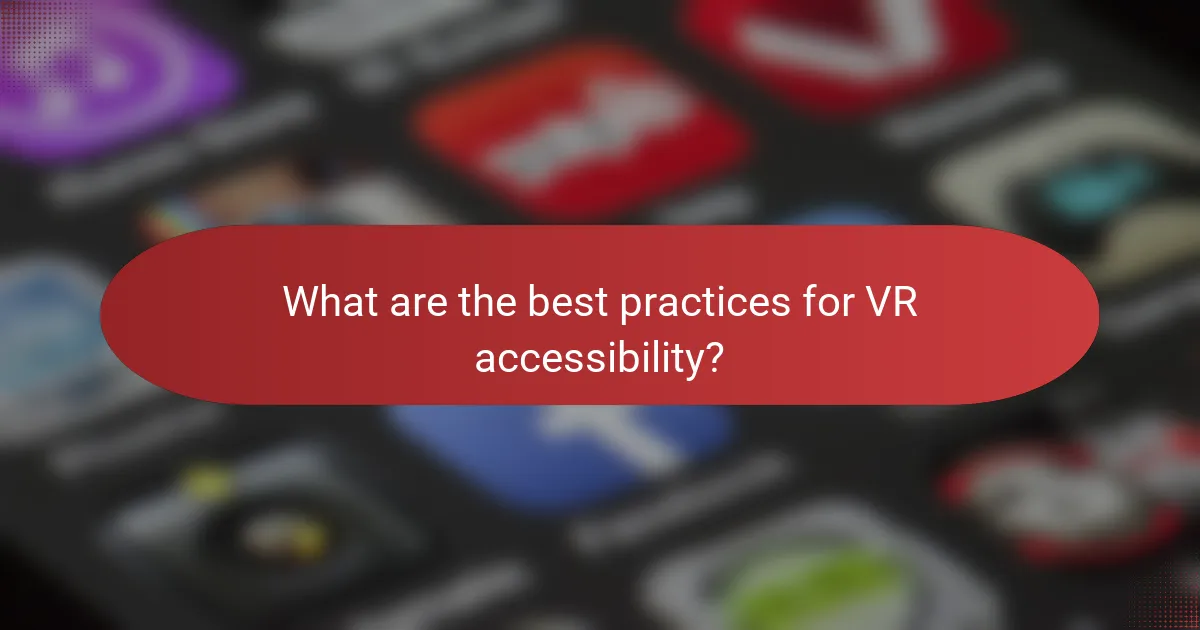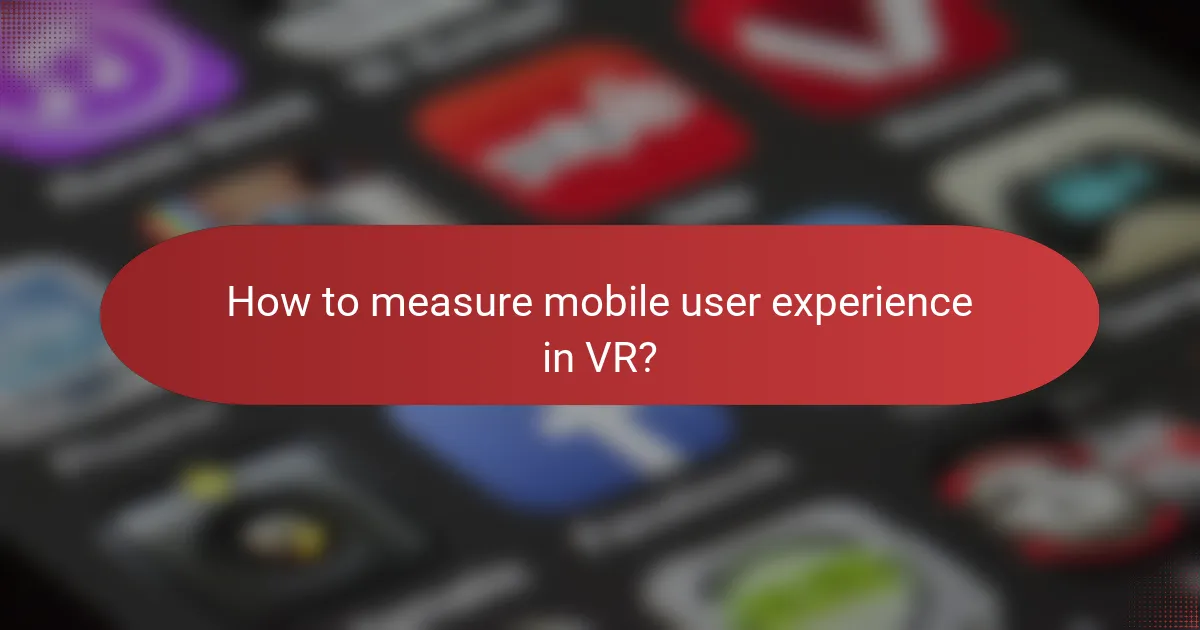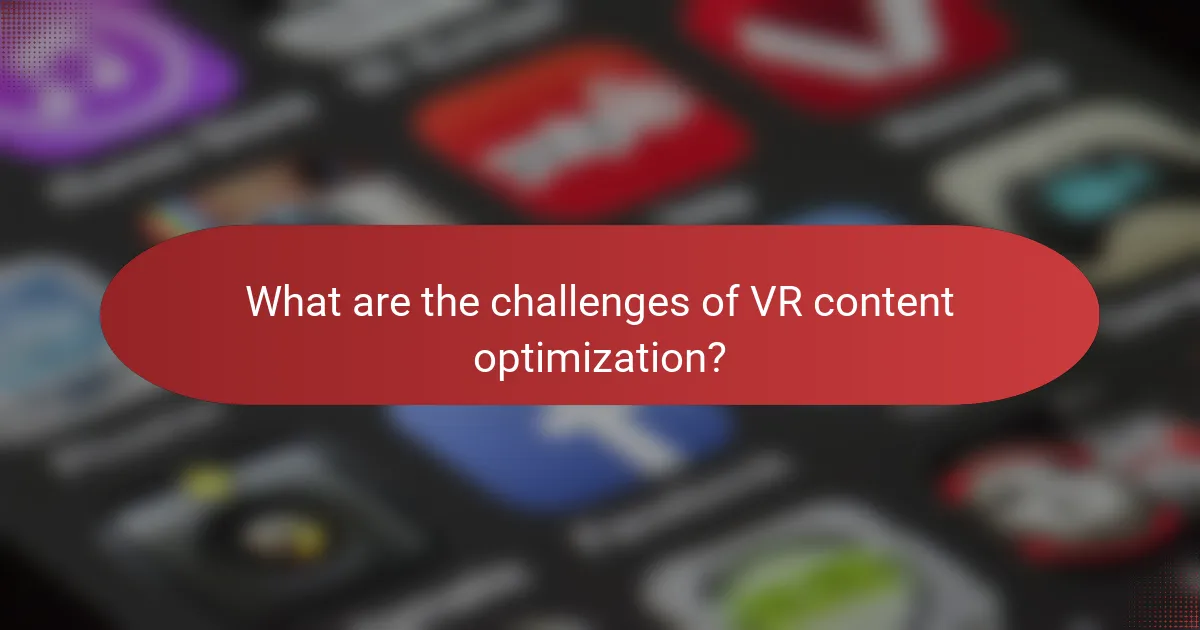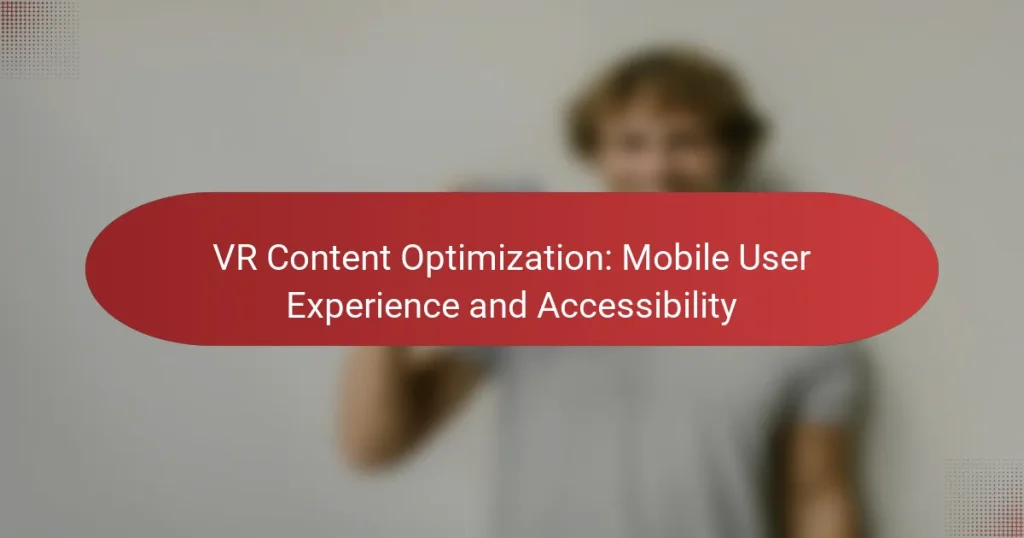Optimizing VR content for mobile users requires a focus on creating immersive, responsive, and accessible experiences tailored to various screen sizes. By implementing best practices in design and accessibility, developers can ensure that all users, including those with disabilities, can navigate and engage with VR environments effectively. Utilizing specialized tools can further enhance usability, making VR experiences more inclusive and enjoyable for everyone.

How to optimize VR content for mobile users in the UK?
To optimize VR content for mobile users in the UK, focus on creating immersive experiences that are responsive, accessible, and efficient. This involves implementing design techniques that cater to various screen sizes and ensuring smooth performance on mobile devices.
Responsive design techniques
Responsive design techniques ensure that VR content adapts seamlessly to different mobile devices. Utilize flexible layouts and scalable graphics to maintain visual integrity across various screen sizes. Implement CSS media queries to adjust the user interface based on device characteristics.
Consider using frameworks like Bootstrap or Foundation, which provide grid systems that facilitate responsive design. This approach helps in delivering a consistent user experience, regardless of whether users are on smartphones or tablets.
Adaptive streaming solutions
Adaptive streaming solutions dynamically adjust the quality of VR content based on the user’s internet connection and device capabilities. This ensures that users receive the best possible experience without excessive buffering or lag. Implement protocols like MPEG-DASH or HLS to facilitate this adaptability.
By analyzing user bandwidth and device performance, you can provide different quality streams, allowing users with slower connections to still engage with the content. This is particularly important in the UK, where internet speeds can vary significantly across regions.
Mobile-friendly user interfaces
Creating mobile-friendly user interfaces is crucial for enhancing user engagement in VR experiences. Focus on touch-friendly controls, larger buttons, and intuitive navigation to accommodate the limitations of mobile devices. Consider using gesture-based controls to enhance interactivity.
Ensure that the interface is simple and clutter-free, allowing users to easily access essential features. Conduct usability testing with real users to identify pain points and make necessary adjustments to improve the overall experience.
Performance optimization strategies
Performance optimization strategies are vital for delivering smooth VR experiences on mobile devices. Minimize the use of heavy graphics and optimize assets to reduce loading times. Techniques such as image compression and efficient coding practices can significantly enhance performance.
Regularly test the VR content on various mobile devices to identify performance bottlenecks. Aim for low latency and high frame rates, ideally targeting 60 frames per second, to ensure a fluid experience. Avoid common pitfalls like excessive animations that can detract from performance.

What are the best practices for VR accessibility?
Best practices for VR accessibility focus on creating immersive experiences that are usable by everyone, including individuals with disabilities. This involves implementing design strategies that accommodate various needs, ensuring that content is navigable and comprehensible for all users.
Inclusive design principles
Inclusive design principles emphasize the importance of considering diverse user needs from the outset. This means engaging with users who have disabilities during the design process to gather insights and feedback. For instance, using adaptable interfaces that allow users to customize controls can enhance usability for individuals with varying abilities.
Additionally, providing multiple ways to interact with content—such as voice commands, gesture controls, and traditional input devices—can make VR experiences more accessible. Always prioritize user testing with a diverse group to identify potential barriers and improve overall accessibility.
Screen reader compatibility
Screen reader compatibility is crucial for users with visual impairments, allowing them to navigate VR environments effectively. Ensure that all interactive elements are labeled clearly and that audio descriptions are available for visual content. This can be achieved by integrating text-to-speech functionality and ensuring that the VR platform supports screen reader software.
Testing with various screen readers can help identify issues and ensure that users can access all necessary information. Providing alternative text for images and audio cues for actions can also enhance the experience for users relying on these tools.
Color contrast guidelines
Color contrast guidelines are essential for users with color blindness or low vision. Aim for a contrast ratio of at least 4.5:1 between text and background colors to ensure readability. Tools like contrast checkers can help designers verify that their color choices meet accessibility standards.
In VR, consider using textures or patterns in addition to color to convey information, as this can assist users who may not perceive certain colors. Regularly reviewing and adjusting color schemes based on user feedback can further improve accessibility and user satisfaction.

Which tools enhance VR content accessibility?
Several tools can significantly improve VR content accessibility, making experiences more inclusive for users with diverse needs. These tools focus on enhancing usability and ensuring that all users can engage with VR environments effectively.
Unity Accessibility Toolkit
The Unity Accessibility Toolkit provides developers with resources to create more accessible VR applications within the Unity engine. It includes features like customizable input options, visual aids, and audio cues that cater to various disabilities.
When using the toolkit, consider implementing adjustable settings for text size, color contrast, and audio descriptions. This flexibility allows users to tailor their experience according to their specific needs, enhancing overall engagement.
Common pitfalls include neglecting to test accessibility features with real users. Always conduct user testing with individuals who have disabilities to gather feedback and make necessary adjustments.
WebXR Accessibility Features
WebXR offers accessibility features that enable developers to create immersive experiences directly in web browsers. These features include support for keyboard navigation, screen readers, and voice commands, making VR content more accessible to a broader audience.
To maximize accessibility with WebXR, ensure that all interactive elements are easily navigable using a keyboard and provide alternative text for visual content. This approach helps users with visual impairments engage with the experience fully.
It’s crucial to stay updated on the latest WebXR specifications and best practices to maintain compliance with accessibility standards. Regularly review and revise your content to align with evolving guidelines and user needs.

How to measure mobile user experience in VR?
Measuring mobile user experience in VR involves assessing how users interact with virtual environments on mobile devices. Key metrics include user engagement, session duration, and feedback on comfort and usability.
User feedback collection methods
Collecting user feedback is essential for understanding the mobile VR experience. Methods include surveys, in-app feedback forms, and user interviews, which can provide qualitative insights into user satisfaction and areas for improvement.
Consider using tools like Google Forms or Typeform for surveys, and ensure questions focus on specific aspects of the VR experience, such as navigation ease and content enjoyment. Aim for concise feedback sessions, ideally lasting no longer than 10 minutes to maintain user engagement.
Analytics tools for VR performance
Analytics tools help track user interactions and performance metrics in mobile VR applications. Popular options include Unity Analytics and Google Analytics, which can monitor user behavior, session lengths, and drop-off rates.
When selecting an analytics tool, prioritize those that offer real-time data and customizable dashboards. This allows for quick adjustments based on user behavior, enhancing the overall mobile VR experience. Regularly review analytics reports to identify trends and make informed decisions about content optimization.

What are the challenges of VR content optimization?
VR content optimization faces several challenges that can hinder the user experience. Key issues include device fragmentation, bandwidth limitations, and user comfort, particularly concerning motion sickness.
Device fragmentation issues
Device fragmentation refers to the variety of hardware and software configurations available in the VR market. Different VR headsets, smartphones, and platforms can lead to inconsistent performance and user experiences. Developers must test their content across multiple devices to ensure compatibility and optimal performance.
To address fragmentation, consider focusing on popular platforms and devices that represent a significant portion of your target audience. Utilizing cross-platform development tools can also help streamline the optimization process.
Bandwidth limitations
Bandwidth limitations can significantly impact the quality of VR content, especially for streaming applications. High-quality VR experiences often require substantial data transfer, which can be challenging in areas with slow internet connections. Users may experience lag or reduced visual fidelity if their bandwidth is insufficient.
To mitigate bandwidth issues, optimize content for lower data rates by compressing assets and using adaptive streaming techniques. Providing offline options can also enhance accessibility for users with limited connectivity.
User comfort and motion sickness
User comfort is critical in VR, as many users experience motion sickness due to discrepancies between visual input and physical movement. Factors such as frame rate, latency, and field of view can influence comfort levels. Ensuring a smooth and responsive experience is essential to minimize discomfort.
To reduce motion sickness, aim for a frame rate of at least 90 frames per second and keep latency below 20 milliseconds. Implementing features like teleportation for movement and providing adjustable settings for users can further enhance comfort and accessibility.

What frameworks support VR content optimization?
Several frameworks facilitate VR content optimization, enhancing user experience and accessibility. Key frameworks include WebXR Device API, A-Frame, and Three.js, each offering unique features for developing immersive VR applications.
WebXR Device API
The WebXR Device API is a crucial framework for creating VR experiences on the web. It allows developers to build applications that can run on various devices, including smartphones and VR headsets, by providing a unified interface for accessing VR hardware capabilities.
When using the WebXR Device API, consider the device’s capabilities, such as tracking and rendering performance. This API supports both immersive VR and augmented reality (AR), enabling a broader range of applications. Developers should ensure their content is responsive and can adapt to different screen sizes and orientations.
To optimize VR content with WebXR, focus on minimizing latency and maintaining a high frame rate, ideally above 60 frames per second. This can be achieved by simplifying 3D models, reducing texture sizes, and optimizing rendering techniques. Testing across multiple devices is essential to ensure a consistent experience.


